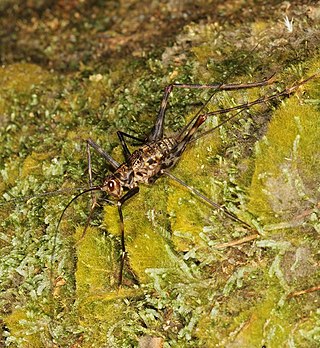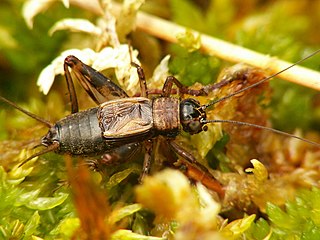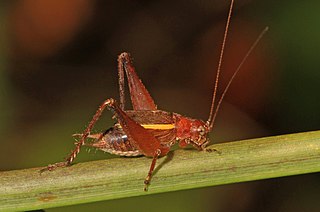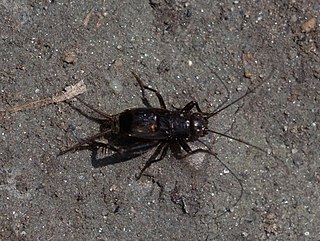
Gryllinae, or field crickets, are a subfamily of insects in the order Orthoptera and the family Gryllidae.

Trigonidiinae is a subfamily of insects in the order Orthoptera, suborder Ensifera, based on the type genus Trigonidium. They are often referred to as sword-tail crickets, winged bush crickets or trigs.

Phalangopsinae, occasionally known as spider crickets, are a subfamily of crickets in the family Phalangopsidae. Members of Phalangopsinae are found worldwide in tropical and subtropical regions. Most species in the subfamily are nocturnal and can be found in rocky areas, near fallen wood, and the understory of forests. Some species are gregarious, gathering in large numbers.

The Eneopterinae are a subfamily of crickets, in the family Gryllidae, based on the type genus Eneoptera. It is one of several groups widely described as "true crickets", but this subfamily may also referred to in American English as "bush crickets". Of the more than 500 species that make up this subfamily, most occur in moist, tropical habitats. These insects are medium to large and brown or gray in color. They eat plant leaves, flowers, and fruits and can occasionally cause economic damage. Their eggs are deposited in pith, bark, or wood. Eneopterinae show a great diversity in stridulatory apparatus, signals emitted, and associated behaviour.

Anaxipha is a genus of brown sword-tail cricket from tropical areas in the Americas, Africa, Asia, Australia and western Pacific islands.

Nemobiinae is a subfamily of the newly constituted Trigonidiidae, one of the cricket families. The type genus is Nemobius, which includes the wood cricket, but members of this subfamily may also be known as ground crickets or "pygmy field crickets".
Hygronemobius is a genus of insects in the family Trigonidiidae.

Hapithus agitator is a species of cricket in the genus Hapithus, in the subfamily Hapithinae. A common name for it is "restless bush cricket". It is found in North America.

Cyrtoxipha is a genus of green trigs in the family Gryllidae. There are at least 30 described species in Cyrtoxipha.

Podoscirtinae is a subfamily of crickets in the family Oecanthidae.

Pteronemobius is a genus of crickets in the subfamily Nemobiinae, with a worldwide distribution.

The Phalangopsidae, which includes the "spider crickets" and their allies, are a recently (2014) reconstituted family of crickets, based on the type genus PhalangopsisServille, 1831 from South America. Priority for family-group names based on this genus dates from Blanchard's "Phalangopsites".

Hapithini is a tribe of crickets in the subfamily Hapithinae. There are about 12 genera and more than 260 described species: found in Central and South America.
Aphonomorphini is a tribe of crickets in the subfamily Hapithinae. There are about 6 genera and more than 90 described species in Aphonomorphini.
Cearacesaini is a tribe of crickets in the subfamily Hapithinae: found in North, Central, and South America. There are at least 4 genera and about 16 described species in Cearacesaini.

Gryllini is a tribe of crickets and typical of the family Gryllidae. Species are terrestrial, carnivorous or omnivorous and can be found in all continenents except Antarctica.
Luzarinaeis a subfamily of crickets in the family Phalangopsidae.

The Oecanthidae are a recently (2022) restored family of crickets based on the type genus OecanthusServille, 1831. They include "tree crickets", "anomalous crickets" and "bush crickets" and can be found in warmer parts of most of the world.

The Tafaliscinae are a subfamily of mostly Neotropical crickets in the recently restored family Oecanthidae and based on the type genus TafaliscaWalker, 1869. They can be found in warmer parts of the Americas and there is a species record from Java.














